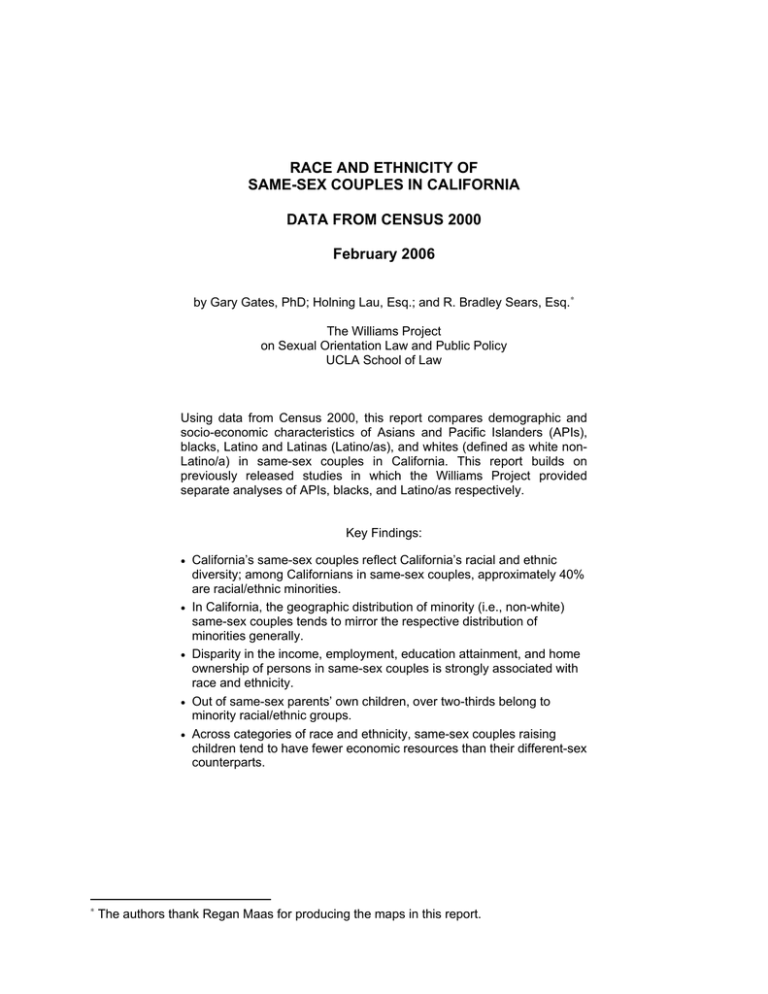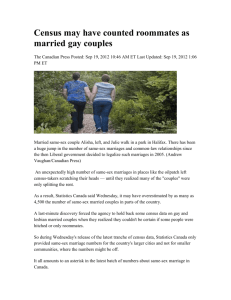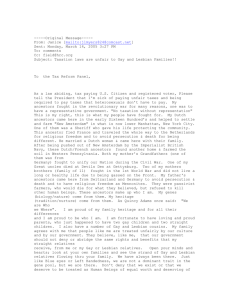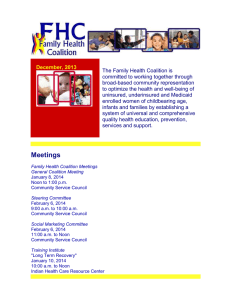
RACE AND ETHNICITY OF
SAME-SEX COUPLES IN CALIFORNIA
DATA FROM CENSUS 2000
February 2006
by Gary Gates, PhD; Holning Lau, Esq.; and R. Bradley Sears, Esq.∗
The Williams Project
on Sexual Orientation Law and Public Policy
UCLA School of Law
Using data from Census 2000, this report compares demographic and
socio-economic characteristics of Asians and Pacific Islanders (APIs),
blacks, Latino and Latinas (Latino/as), and whites (defined as white nonLatino/a) in same-sex couples in California. This report builds on
previously released studies in which the Williams Project provided
separate analyses of APIs, blacks, and Latino/as respectively.
Key Findings:
•
•
•
•
•
∗
California’s same-sex couples reflect California’s racial and ethnic
diversity; among Californians in same-sex couples, approximately 40%
are racial/ethnic minorities.
In California, the geographic distribution of minority (i.e., non-white)
same-sex couples tends to mirror the respective distribution of
minorities generally.
Disparity in the income, employment, education attainment, and home
ownership of persons in same-sex couples is strongly associated with
race and ethnicity.
Out of same-sex parents’ own children, over two-thirds belong to
minority racial/ethnic groups.
Across categories of race and ethnicity, same-sex couples raising
children tend to have fewer economic resources than their different-sex
counterparts.
The authors thank Regan Maas for producing the maps in this report.
KEY FINDINGS
California’s same-sex couples reflect California’s racial and ethnic diversity.
Among Californians in same-sex couples, approximately four out of every ten are
racial/ethnic minorities.1
1(a). Race/Ethnicity of Californians in Same-sex Couples
Whites 61%
Latino/as 25%
39% of
Californians
in same-sex
couples are
racial/ethnic
minorities
APIs 6%
Blacks 4%
Multiracials and Others 3%
Alaskan Natives &
American Indians 1%
California ranks first in the number of APIs, Latino/as, and whites in same-sex couples.
California ranks third in the number of blacks who belong to same-sex couples.
1(b). States with the Largest Numbers of
Unmarried (Cohabiting) Same-sex Partners, by Race/Ethnicity
Rank
1
2
3
4
5
APIs
California
13,288
New York
4,775
Hawaii
2,186
Texas
1,989
New Jersey
1,498
Blacks
New York
13,091
Georgia
9,980
California
9,590
Texas
9,553
Florida
8,725
Latino/as
California
44,821
Texas
23,626
New York
13,322
Florida
12,376
Illinois
6,651
1
Whites
California
116,786
New York
62,258
Florida
59,413
Texas
49,913
Pennsylvania
36,091
Racial/ethnic minorities include (1) all persons who did not identify themselves as “White” when
completing their census forms, and (2) all persons who identified themselves as “White,” but also as
“Spanish/Hispanic/Latino.”
2
KEY FINDINGS
In California, the geographic distribution of minority (i.e., non-white) same-sex couples
tends to mirror the respective distribution of minorities generally.
2(a). Geographic Distribution of Non-whites, Same-sex Households v. All Households
In contrast, white same-sex couples’ geographic distribution is not as closely tied to the
broader distribution of the white population.
2(b). Geographic Distribution of Whites, Same-sex Households v. All Households
3
Within counties, the geographic distribution of minority same-sex couples also tends to mirror
the general distribution of minorities. For example, in Los Angeles County, same-sex couples
tend to live where there are high concentrations of the couples’ respective race/ethnicity.
2(c). Locations of Ethnic Pluralities, All Household v. Same-sex Households
4
KEY FINDINGS
Disparity in the income, employment, educational attainment, and home ownership of
persons in same-sex couples is strongly associated with race and ethnicity.
3(a-d). Socio-economic Characteristics, by Race/Ethnicity and Couple Type
Percentage of Individuals
with College Degrees
Mean Individual Income
$ 60,000
60%
50,000
50.6
46.5
48
40,000
41
34.9
43
36.3
30,000
35
31.5
31.5
26
23.7 21.5
20,000
20
13
10,000
8
0%
0
APIs
Blacks
Latino/as
APIs
Whites
Blacks
Latino/as
Whites
Percentage of Couples
Who Own Their Home
Percentage of Individuals Employed
90%
80%
77
75
65
58
63
55
67
65
66
65
49
43
64
39
61
58
50%
APIs
Blacks
Latino/as
0%
Whites
Same-Sex Couples
APIs
Blacks
Different-Sex Couples
5
Latino/as
Whites
KEY FINDINGS
Out of same-sex parents’ own children, over two-thirds belong to minority racial/ethnic
groups.
Over 70,500 Californian children are being raised by same-sex parents. Among them,
roughly 58,600 are the same-sex parents’ “own” children (Sears and Badgett).2
4. Race/Ethnicity of Same-sex Couples’ Own Children
Latino/as 53%
APIs 8%
Blacks 6%
71% of the
children are
racial/ethnic
minorities
Multiracials and
all Others 4%
Whites 29%
2
The Census category of “own” children refers to children who are biologically-related to, adopted by, or stepchildren of the householder. Children who live with same-sex couples, but are not those couples’ “own children,”
include foster children and other children who are not related to the couple.
6
KEY FINDINGS
Across categories of race and ethnicity, same-sex couples raising children tend to have
fewer resources than their different-sex counterparts.
5(a). Mean Household Income of Couples3 Raising Their Own Children,
by Race/Ethnicity and Couple Type
$ 100,000
80,000
60,000
40,000
20,000
0
Latinos
Blacks
APIs
Same-sex Couples
Whites
Different-sex Couples
Same-sex couples that are racial/ethnic minorities are much more likely than their white
counterparts to be raising their own children. These same-sex racial/ethnic-minority parents
tend to be poorer than their white counterparts.
5(b). Prevalence and Income of Same-sex Couples3
Raising Their Own Children, by Race/Ethnicity
70%
Percentage of
couples raising
their own children 60%
Latino/as
50%
Blacks
APIs
40%
30%
20%
Whites
10%
0%
$0
$20,000
$40,000
$60,000
$80,000
$100,000
$120,000
Mean household income of same-sex parents
3
For this graph, we controlled for age by including only couples in which both partners are between the ages of 2555.
7
DATA, TERMINOLOGY, AND METHODOLOGY
Data
Data for this report come from several Census 2000 public data releases. Geographic data are
drawn from Summary File-2, a set of tables describing characteristics of households based on
the race/ethnicity of the “householder,” the person who filled out the census form.
Estimates of other demographic characteristics are made using the Census 2000 Public Use
Microdata Samples (PUMS). The 5% PUMS represents a one in four sample of the
approximately 26% of American households that filled out a census long-form. The 1% PUMS
represents a one in sixteen sample of the same households. The census long-form contains
detailed information about all members of the household, including citizenship, country of origin,
and a variety of demographic and economic characteristics.
Terminology
In this report, the term “black” refers to all persons who identified their race as “Black, African
Am., or Negro” when completing the census forms. Similarly, “Asians and Pacific Islanders”
(“APIs”) refers to all persons who identified their race as one of eleven API categories listed in
the census forms.4 “Latinos and Latinas” (“Latino/as”) are defined as those who identified their
ethnicity as “Spanish/Hispanic/Latino” when filling out the census forms. All persons who
identified as such, regardless of how they identified themselves racially, are designated as
Latino/a in this report. The term “white” refers to all persons who (1) identified their race as
“White” when completing the census forms, and (2) did not identify as Latino/a.
It should be noted that, as a result of these definitions, the black, API, and Latino/a groups
generally are not mutually exclusive because some individuals in the Latino/as category are
also included in the black and/or API categories. Charts 1(a) and 4 are exceptions to this rule.
To ensure that the figures in those charts summed to 100 percent, Latino/as who identified
themselves as black or API were included in the Latino/a category, but excluded from the black
and API categories.
In this report, the term “black couples” refers to couples in which both partners are black; “white
couples” refers to couples in which both partners are white; etc. Although a significant portion of
same-sex couples in California are inter-racial, they were excluded from this report in order to
facilitate comparisons across racial/ethnic categories. For data pertaining specifically to interracial couples, see the studies by Gates and Sears listed in the Reference section of this report.
4
Those census categories included Asian Indian, Chinese, Filipino, Japanese, Korean, Vietnamese, Other Asian,
Native Hawaiian, Guamanian or Chamorro, Samoan, and Other Pacific Islander.
DATA, TERMINOLOGY, AND METHODOLOGY
Methodology
Characteristics of same-sex couples and their families are estimated using a sample of those
families drawn from both the 5% and 1% PUMS files for the State of California. The California
sample includes 6,037 same-sex couples.
Characteristics of different-sex couples and their families are estimated using the 1% PUMS
sample only. This sample includes 65,669 different-sex couples in California.
Same-sex couples are identified from the roster that the householder uses to describe how
every person in the house is related to him or her. These same-sex couples are commonly
understood to be primarily gay and lesbian couples even though the Census does not ask any
questions about sexual orientation, sexual behavior, or sexual attraction (three common ways
used to identify gay men and lesbians in surveys). Rather, census forms include a number of
relationship categories to define how individuals in a household are related to the householder.
These fall into two broad categories: related persons (including husband/wife, son/daughter,
brother/sister, etc.) and unrelated persons (including unmarried partner, housemate/roommate,
roomer/border, other non-relative, etc.).
Since 1990, the Census Bureau has included an “unmarried partner” category to describe an
unrelated household member’s relationship to the householder. If the householder describes
another adult of the same sex as his or her “unmarried partner” or “husband/wife,” the
household counts as a same-sex unmarried partner household (see Gates and Ost 2004 for a
detailed explanation of counting same-sex couples).
The Census data regarding same-sex couples do not capture all gay men and lesbians in the
United States for at least two important reasons. First, the Census only captures data about
same-sex couples of which one person in the couple is the partner of the householder. The
Census does not identify single gay men and lesbians. Limited data make it difficult to assess
exactly how coupled gay men and lesbians might differ from their single counterparts, but in the
general population, single people tend to be younger, less educated, and have lower incomes
than their coupled counterparts.
In addition, the Census most likely undercounts even the population of same-sex couples.
There are several potential reasons for suspecting an undercount. Concerns about revealing
their sexual orientation (even indirectly) to the federal government may have led many gay and
lesbian couples to indicate a status that would not indicate the true nature of their relationship.
Other couples may have felt that “unmarried partner” or “husband/wife” does not accurately
describe their relationship. A study of the undercount of same-sex unmarried partners in
Census 2000 indicates that these were the two most common reasons that gay and lesbian
couples chose not to designate themselves as unmarried partners (Badgett and Rogers 2003).
Census tabulations also would not capture couples who do not live together and couples living
in a household with someone else who filled out the census form. While determining the size of
this undercount is challenging, estimates suggest that the true counts are 10 to 50 percent
higher than the Census figures (Gates and Ost 2004).
In addition to undercounting the number of same-sex couples in the population, the Census may
erroneously include some different-sex couples in the same-sex couple population. Gates and
Ost (2004) describe a measurement error resulting from different-sex married couples
9
inadvertently checking the incorrect sex of one of the partners. This error, although thought to
be small, may impact some of the characteristics of same-sex couples. For example, estimates
of child-rearing among same-sex couples could be overstated due to this sample error because
different-sex couples are more likely to have children. The magnitude of this error is not easily
ascertained, but Gates and Ost suggest that while national unadjusted figures show that 28.2%
of same-sex couples are raising children, a more accurate estimate that attempts to adjust for
the presence of different-sex couples is 27.5%. The estimates of child-rearing in this report do
not adjust for this form of error and thus may somewhat overstate this characteristic.
10
REFERENCES
Allegretto, Sylvia and Michelle Arthur (2001). “An Empirical Analysis of
Homosexual/Heterosexual Male Earnings Differentials: Unmarried and Unequal?,” Industrial
and Labor Relations Review, 54(3): 631-646.
Badgett, M. V. (2001). Money, Myths, and Change: The Economic Lives of Lesbians and Gay
Men, Chicago: University of Chicago Press.
Badgett, M. V. (1995). “The Wage Effects of Sexual-Orientation Discrimination,” Industrial and
Labor Relations Review, 48(4): 726-739.
Badgett, M.V. Lee and Marc A. Rogers (2003). “Left Out of the Count: Missing Same-Sex
Couples in Census 2000.” Amherst, MA: Institute for Gay and Lesbian Strategic Studies.
Black, Dan, Gary Gates, Seth Sanders, and Lowell Taylor (2000). “Demographics of the Gay
and Lesbian Population in the United States: Evidence from Available Systematic Data
Sources,” Demography, 37(2): 139-154.
Black, Dan, Gary Gates, Seth Sanders, and Lowell Taylor (2002). “Why do Gay Men Live in
San Francisco?,” Journal of Urban Economics, 51(1): 54-76.
Black, Dan, Hoda Makar, Seth Sanders, and Lowell Taylor (2003). “The Earnings Effects of
Sexual Orientation,” Industrial and Labor Relations Review, 56(3): 449-469.
Gates, Gary J. and Jason Ost (2004). The Gay and Lesbian Atlas. Washington, DC: Urban
Institute Press.
Gates, Gary J. and R. Bradley Sears (2005).
-- “Asians and Pacific Islanders in Same-Sex Couples in California: Data from Census
2000,” Los Angeles, CA: The Williams Project on Sexual Orientation Law and Public Policy.
-- “Black Same-Sex Couples in California: Data from Census 2000,” Los Angeles, CA: The
Williams Project on Sexual Orientation Law and Public Policy.
-- “Latino/as in Same-Sex Couples in California: Data from Census 2000,” Los Angeles, CA:
The Williams Project on Sexual Orientation Law and Public Policy.
Sears, R. Bradley and Badgett, M.V. Lee (2004). "Same-Sex Couples and Same-Sex Couples
Raising Children in California,” Los Angeles, CA: The Williams Project on Sexual Orientation
Law and Public Policy.
Simmons, Tavia and Martin O’Connell (2003). “Married-Couple and Unmarried-Partner
Households: 2000.” Washington, DC: U.S. Department of Commerce, Economics.
11





![Peter Collard [Details removed] Dear Sir and/or Madam National](http://s3.studylib.net/store/data/007613680_2-0e9d06f34ba7c7a5a822dec6a16b6bcf-300x300.png)


